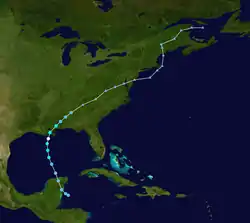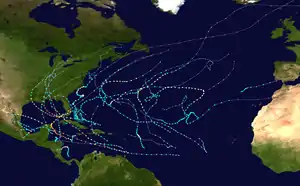Hurricane Cindy (2005)
Hurricane Cindy was a tropical cyclone that briefly reached minimal hurricane strength in the Gulf of Mexico during July in the 2005 Atlantic hurricane season and made landfall in Louisiana. It was the third named storm and first hurricane of the season. Cindy was originally thought to have been a tropical storm at peak strength, but was upgraded to a Category 1 hurricane in the post-storm analysis. Cindy formed on July 3 just east of the Yucatán Peninsula in the Caribbean Sea. The depression soon made landfall on the peninsula and weakened before reemerging in the Gulf of Mexico on July 4. The storm strengthened as it moved north becoming a hurricane just before making landfall near Grand Isle, Louisiana, on July 5. The storm weakened as it moved overland and became extratropical on July 7.
| Category 1 hurricane (SSHWS/NWS) | |
 Cindy shortly before reaching hurricane intensity south of New Orleans on July 5 | |
| Formed | July 3, 2005 |
|---|---|
| Dissipated | July 12, 2005 |
| (Extratropical after July 7) | |
| Highest winds | 1-minute sustained: 75 mph (120 km/h) |
| Lowest pressure | 991 mbar (hPa); 29.26 inHg |
| Fatalities | 3 total |
| Damage | $320 million (2005 USD) |
| Areas affected | Yucatán Peninsula, North Carolina, South Carolina, Alabama, Mississippi, Louisiana |
| Part of the 2005 Atlantic hurricane season | |
The storm was responsible for 3 deaths in the United States and brought heavy rains to Louisiana, Mississippi, Alabama and Maryland. An unusually strong F2 tornado was spawned from Cindy's remnants and caused severe damage in Hampton, Georgia. Cindy also caused flooding and a severe blackout in New Orleans, Louisiana.
Meteorological history

On June 24 a vigorous tropical wave moved off the African coast and quickly west across the Atlantic without developing. The wave gradually became more organized as it crossed the Caribbean and late on July 3 it strengthened into Tropical Depression Three about 80 miles (130 km) east of Chetumal, Mexico.[1] The models initially had difficulty predicting the track of the depression and the forecasts from the National Hurricane Center reflected this, indicating that the depression would move towards Texas.[2] The depression developed quickly before making landfall on Yucatán Peninsula early on July 4 with 35 mph (55 km/h) winds and began to lose its circulation overland.[1] A new center of circulation began forming later on July 4, over the Gulf of Mexico, to the north of the original center. This reformation caused a significant alteration in the forecast models, which now indicated a landfall in Louisiana.[3] The depression moved northwards into the Gulf of Mexico and became a tropical storm early on July 5, assigned the name Cindy.
Weakened shear allowed Cindy to strengthen further as it approached Louisiana and the storm was a minimal hurricane with 75 mph (120 km/h) winds when it made landfall near Grand Isle late on July 5.[1] Initially it was stated that Cindy did not reach hurricane strength, but post-season reanalysis confirmed the upgrade to Category 1 status.[1][4] Cindy weakened back into a tropical storm as it crossed over extreme southeastern Louisiana and Breton Sound before making a second landfall near Waveland, Mississippi with 50 mph (85 km/h) winds on July 6. Cindy moved to the northeast over Mississippi and Alabama, weakening to a tropical depression that day. The depression became extratropical over the Carolinas on July 7 and moved to the northeast dissipating in the Gulf of St Lawrence on July 12.[1]
Preparations

Upon being declared a tropical depression, meteorologists in Mexico began advising residents about the possibility of heavy rainfall across the Yucatán Peninsula.[5]
The National Hurricane Center issued a Tropical Storm Warning from Morgan City, Louisiana to Destin, Florida,[6] and both tourists and residents evacuated the Louisiana and Florida coasts.[7] Workers were evacuated from six oil rigs in the storm's path,[8] and 23 coastal refineries stopped unloading oil as Cindy's approach made such activities dangerous.[9] Numerous flights in and out of New Orleans were cancelled and Amtrak suspended passenger rail service until after the storm passed. Recreational vehicles were told to leave Grand Isle in case a full-scale evacuation was needed. In Mississippi, jail inmates filled sandbags which would be distributed to flood prone areas throughout the state.[8]
Impact

Three deaths were attributed to Cindy, none of them near the storm's landfall. One person was killed in Georgia,[1] and two in Maryland from a car crash.[10] Approximately 300,000 homes and businesses in southeast Louisiana and the Mississippi Gulf Coast lost electrical power and a storm surge of 4–6 feet (1.2-1.8 m) affected the same area, causing some beach erosion near Grand Isle, Louisiana. Hurricane Cindy's total damage was estimated to be US$320 million.[1]
In New Orleans, Louisiana, wind gusts reached 70 mph (110 km/h), many trees were damaged or uprooted[7] and scattered street flooding was reported. As thousands lost electrical power, the city experienced its worst blackout since Hurricane Betsy 40 years earlier. Although still listed as a "Tropical Storm" by the weather service at the time, many laypeople in New Orleans were under the impression that Cindy was a hurricane, and referred to it as "Hurricane Cindy" before it was officially upgraded.[11][12] Many people in the New Orleans metropolitan area expected minimal effects from the storm, but were cleaning up debris and were without power for days after Cindy's passage.[13][14] In Louisiana, 260,000 residences were left without power.[15]
Even though it had weakened to a depression when it moved inland, Cindy's effects were still significant across the final portion of its track. The day after its landfall in southeastern Louisiana, Tropical Depression Cindy reached central Alabama. There its rainbands produced heavy rainfall and eight tornadoes.[16] Damage was mostly limited to trees and powerlines, but an F1 tornado in Macon county injured one man, destroyed an auto-repair shop, and damaged several nearby cars.[17] About 35,000 residences in Alabama and 7,000 in both Florida and Mississippi were left without power following the storm.[15]
In Georgia, some parts of Atlanta Motor Speedway and Tara Field airport in Hampton, Georgia suffered US$40 million damage from an F2 tornado spawned by the storm.[18] An F1 tornado in Fayette county damaged three homes and caused an estimated US$3 million of damage.[19] Four other tornadoes were confirmed across the state, although none of them caused significant damage.[20] Hartsfield-Jackson Atlanta International Airport in Atlanta recorded over 5 inches (130 mm) of rain on July 6, its sixth-highest one-day rainfall since records began in 1878;[21] most of the rain fell during just two hours (8–10 p.m. EDT). This is more rain than the area normally gets in all of July.[22]
Cindy's remnant low moving across western and northern North Carolina combined with a frontal boundary to produce several supercell thunderstorms. These supercells spawned a number of tornadoes in western North Carolina, at the foothills of the Appalachian mountains, but their effects were minimal.[23] Continuing north, Cindy brought over 5 in (125 mm) of rain to areas as distant as Salisbury, Maryland.[24] In addition, Cindy's remnants produce moderate rainfall in Upstate New York causing light damage due to flooding and gusty winds, which downed some trees.[25]
See also
- List of Florida hurricanes (2000–present)
- List of North Carolina hurricanes (2000–present)
- List of Category 1 Atlantic hurricanes
- Tropical Storm Arlene (2005) – Affected similar areas earlier in the year.
- Hurricane Barry (2019)
References
- National Hurricane Center (February 14, 2006). "Tropical Cyclone Report: Hurricane Cindy" (PDF). NOAA. Retrieved May 15, 2006.
- National Hurricane Center (July 3, 2005). "Discussion for Tropical Depression Three, 11 p.m. EDT, July 3, 2005". NOAA. Retrieved May 15, 2006.
- National Hurricane Center (July 4, 2005). "Discussion for Tropical Depression Three, 5 p.m. EDT, July 4, 2005". NOAA. Retrieved May 15, 2006.
- National Hurricane Center (July 5, 2005). "Discussion for Tropical Storm Cindy, 11 p.m. EDT, July 5, 2005". NOAA. Retrieved May 15, 2006.
- Staff Writer (July 3, 2005). "Aviso 01 de la Depresión Tropical "03" 03/jul/2005 19:30 h" (in Spanish). Comisión Federal de Electricidad. Retrieved November 7, 2009.
- Stewart (July 5, 2005). "Tropical Storm Cindy Intermediate Advisory 9a, Corrected". National Hurricane Center. Retrieved August 9, 2008.
- Staff Writer (July 5, 2005). "Weather-watchers eye Dennis as Cindy drenches Louisiana". CBC News. Retrieved August 9, 2008.
- "Tropical Storm Cindy Heads for Louisiana". Fox News. Associated Press. July 5, 2005. Retrieved March 17, 2009.
- Staff Writer (July 6, 2005). "Tropical Storm Dennis Approaches Gulf of Mexico; Cindy Weakens". Bloomberg. Retrieved August 9, 2008.
- "Event Record Details: Maryland". National Climatic Data Center. 2005. Retrieved December 28, 2008.
- B.J. and Tony. "The Adventures of BJ and Tony Morris - New Orleans, Louisiana". Archived from the original on February 18, 2007. Retrieved March 18, 2007.
- Rick Minter (October 30, 2005). "Speedy recovery for Atlanta Motor Speedway". The Atlanta Journal-Constitution and TheConservativeVoice.com. Archived from the original on October 9, 2008. Retrieved August 12, 2008.
- Niki King (December 5, 2005). "Katrina victims make Christiansburg a home". The Roanoke Times. Archived from the original on January 4, 2013. Retrieved August 12, 2008.
- Karen Gleason (September 11, 2005). "Louisiana family calling Del Rio home". Del Rio News-Herald. Retrieved August 12, 2008.
- "Tropical Storm Cindy floods streets along Gulf Coast". USA Today. Associated Press. July 8, 2005. Retrieved March 17, 2009.
- National Weather Service, Birmingham, AL (January 24, 2006). "Remnants of Hurricane Cindy". National Weather Service. Retrieved August 12, 2008.CS1 maint: multiple names: authors list (link)
- National Weather Service Forecast Office, Birmingham, AL (March 21, 2006). "Macon County F1 Tornado During Tropical Storm Cindy, July 6, 2005". National Weather Service. Archived from the original on September 7, 2008. Retrieved August 12, 2008.CS1 maint: multiple names: authors list (link)
- National Weather Service Forecast Office (July 8, 2005). "Damage to Atlanta Motor Speedway and Tara Field due to Tropical Storm Cindy". National Weather Service. Retrieved August 12, 2008.
- National Weather Service Forecast Office (August 25, 2005). "Damage in Fayette County due to Tropical Storm Cindy, July 6, 2005". National Weather Service. Retrieved August 12, 2008.
- Staff (July 7, 2005). "Preliminary Tornado Damage Reports from the Remnants of Tropical Storm Cindy". National Weather Service, Peachtree City, GA. Archived from the original on June 13, 2007. Retrieved August 12, 2008.
- National Weather Service Forecast Office (August 25, 2005). "Georgia Feels Cindy's Wrath - July 6, 2005". National Weather Service. Archived from the original on May 5, 2008. Retrieved August 12, 2008.
- Computer Generated (August 1, 2005). "History for Atlanta, GA:Month of July, 2005". Weather Underground. Retrieved August 12, 2008.
- Jonathan Blaes (July 18, 2005). "Tropical Storm Cindy, July 2005". National Weather Service, Raleigh NC. Retrieved August 12, 2008.
- David Roth (May 1, 2008). "Hurricane Cindy Rainfall Summary". Hydrometeorological Prediction Center. Retrieved August 12, 2008.
- National Climatic Data Center (2005). "Event report for Hurricane Cindy". Archived from the original on May 20, 2011. Retrieved February 8, 2008.
External links
| Wikimedia Commons has media related to Hurricane Cindy (2005). |
- The NHC's Tropical Cyclone Report on Hurricane Cindy.
- The NHC's archive on Hurricane Cindy.
- The HPC's archive on Hurricane Cindy.
- USA Today: Tropical Storm Cindy floods streets along Gulf Coast
- Photos of Cindy on al.com
- Times-Picayune article the following day via ohsep.louisiana.gov
- NASA article on Cindy's rainfall
